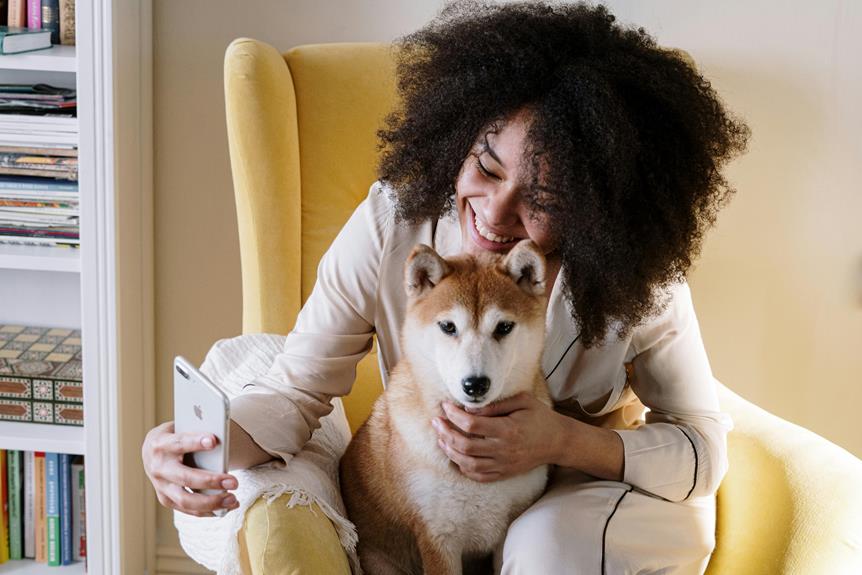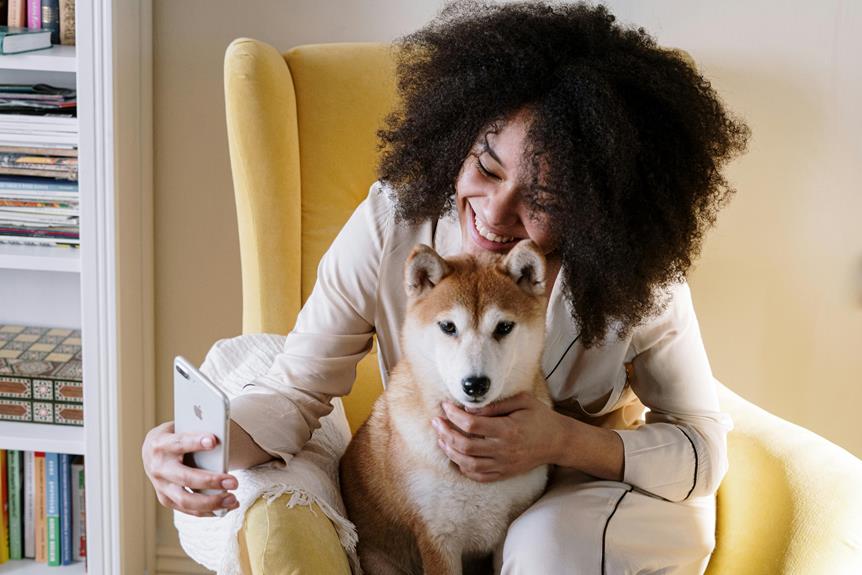7 Best Portrait Mode Settings for Iphone
To capture stunning portraits with my iPhone, I prioritize mastering the right settings. Natural light is key, especially during the golden hour, and I place my subject near a north-facing window or shoot at a 45-degree angle for added depth. In Portrait mode, I use the tap-to-focus technique, adjusting exposure compensation for balanced lighting. I also experiment with backlight, adjusting its intensity to set the mood. For low-light shots, I minimize noise with the lowest ISO and use image stabilization. To perfect my portraits, I fine-tune the depth control slider and explore advanced editing tools for further refinement.
Key Takeaways
- Use the Portrait mode in low-light conditions by enabling the Flash option for enhanced image quality and softer light on skin tones.
- Position the subject near a light source and experiment with angles at 45 degrees to add depth and dimension to portraits.
- Tap-to-focus technique sharpens the subject, and ideal distance is 8-10 feet for perfect focus in Portrait mode.
- Adjust the Depth Control slider in real-time to experiment with different levels of background blur and bokeh effects.
- Enable the Night mode in Portrait mode by swiping to the left to capture multiple frames for reduced noise and enhanced color.
Natural Light Portrait Setting
Using natural light when shooting in Portrait mode, I often find myself favoring spots near windows or outside during the golden hour. This time frame, typically early morning or late afternoon, provides soft, warm light that creates a flattering atmosphere for portraits. When shooting near windows, I consider the direction of the light and its intensity. A north-facing window, for example, offers soft, indirect light, while a south-facing window provides more direct, intense light.
Experimenting with different lighting angles is vital to achieve the desired effect. I find that shooting with the light source at a 45-degree angle creates a more dynamic portrait. This angle adds depth to the subject's face and creates a sense of dimension. To enhance this effect, I make sure to position the subject near the light source, allowing the shadows to fall naturally.
Mastering natural light techniques is essential for capturing stunning portraits. By understanding how light behaves and how to manipulate it, I can achieve a level of depth and dimension that artificial light often can't replicate. When shooting in Portrait mode, I always look for opportunities to incorporate natural light into my composition. By doing so, I can create portraits that are not only visually striking but also full of character and emotion. With practice and patience, you can master the art of using natural light to elevate your Portrait mode shots.
Close Up Portrait Mode
When using Close Up Portrait Mode on my iPhone, I find it essential to perfect the focus on my subject. This involves ensuring the camera is at the right distance and that the subject is positioned correctly within the frame. By doing so, I can also experiment with different background blur effects to enhance the overall portrait.
Perfecting the Focus
The Portrait mode on an iPhone allows for a close-up shot that puts the subject in sharp focus while blurring the background. To perfect the focus in a close-up Portrait mode shot, I adjust the focus by tapping on the screen where I want the focus to be. This technique, known as "tap-to-focus," is a fundamental focus technique that helps create a sharp image of my subject. I also make certain that the subject is within the ideal range of 8-10 feet from the camera to achieve the best depth perception.
Additionally, I adjust the exposure compensation by swiping up or down on the sun/cloud icon to fine-tune the brightness and contrast of the image. This adjustment helps maintain a balanced exposure and depth perception in the image. I also make certain that the subject is placed in a way that creates a clear distinction between the subject and the background, making the most of the Portrait mode's ability to blur the background. By mastering these focus techniques, I can create high-quality Portrait mode images with excellent depth perception and a sharp, in-focus subject.
Background Blur Effects
I achieve more visually appealing Portrait mode images by experimenting with different background blur effects. Close Up Portrait mode on my iPhone allows me to manipulate the bokeh, creating a more professional look. I've found that the lens choice greatly impacts the background blur effect. The telephoto lens (2x or 2.5x) produces a more pronounced bokeh, ideal for close-up portraits, while the wide-angle lens (1x) is better suited for full-body portraits.
To enhance the background blur effect, I use the Depth Control feature, which adjusts the amount of blur applied to the image. I can choose from a range of f-stops, from f/1.4 to f/16, to achieve the desired level of bokeh. I also take advantage of the iPhone's advanced bokeh techniques, such as the ability to blur complex backgrounds and edges.
Using Backlight Effectively
Natural light coming from behind your subject can make or break a Portrait mode shot. When used effectively, backlight can create stunning silhouette effects or add depth to your image. However, if not positioned correctly, it can result in an overexposed or underexposed photo.
To use backlight effectively, take into account the following techniques:
- Position the backlight to the side: Instead of placing the backlight directly behind your subject, try positioning it to the side. This will create a more subtle effect and prevent the backlight from overpowering the rest of the image.
- Use the backlight to separate the subject: Backlight can be used to create a sense of depth in your image by separating the subject from the background. Position the backlight so that it creates a clear distinction between the subject and the background.
- Experiment with different backlight intensities: The intensity of the backlight can greatly affect the overall mood of the image. Experiment with different backlight intensities to find the one that works best for your shot.
When using backlight in Portrait mode, it's crucial to think about the backlight positioning to achieve the desired effect. By experimenting with different techniques, you can create stunning silhouette effects or add depth to your image. Remember to adjust the exposure compensation to balance the backlight with the rest of the image, and don't be afraid to experiment with different backlight intensities to find the one that works best for your shot.
Shooting in Low Light
When shooting in low light, I need to be mindful of noise and grain that can degrade my Portrait mode images. To minimize these issues, I adjust my iPhone's settings to optimize low-light performance. I also consider using Night mode, which can greatly improve the quality of my portraits taken in dimly lit environments.
Minimizing Noise and Grain
Shooting in low light often brings the challenge of minimizing noise and grain in your Portrait mode photos. To combat this, I rely on a combination of camera settings and shooting techniques to produce the best results.
When shooting in low light, it's crucial to make the most of the available light. Here are a few techniques I use to minimize noise and grain:
- Opt for the telephoto lens: The telephoto lens on your iPhone tends to produce less noise than the wide-angle lens, making it a better choice for low-light Portrait mode shots.
- Use image stabilization: Enable image stabilization to help reduce camera shake and blur, which can exacerbate noise and grain.
- Use the lowest ISO possible: Keep an eye on the ISO settings and use the lowest possible value to minimize noise and grain.
In addition to these techniques, I also use editing software to apply noise reduction and fine-tune the image. By combining these methods, I can produce high-quality Portrait mode photos even in low-light conditions.
Utilizing Night Mode
I've found Night mode to be a game-changer for Portrait mode photos taken in low light, allowing me to capture high-quality images that would otherwise be compromised by excessive noise and grain. This feature combines multiple frames to produce an image with reduced noise and improved color accuracy. One of the key night mode advantages is its ability to capture stunning portraits in low-light conditions.
When using Night mode, it's important to master specific shooting techniques. Here are some tips:
| Shooting Techniques | Night Mode Tips |
|---|---|
| Stabilize the camera | Use a tripod or hold the iPhone steady to minimize camera shake |
| Focus on the subject | Tap on the subject's face to guarantee the camera focuses correctly |
| Adjust exposure | Swipe up or down to adjust the exposure and balance the lighting |
| Use a slower shutter | Enable a slower shutter speed to capture more light and create a more natural bokeh |
| Pay attention to lighting | Position the subject near a light source to reduce harsh shadows and improve overall lighting |
Portrait Mode With Flash
One key feature to bear in mind when using Portrait mode is the option to turn on the flash. This feature is particularly useful in low-light conditions where a flash can help to illuminate the subject's face and enhance the overall quality of the image.
When using the flash in Portrait mode, it is crucial to keep in mind a few key tips to get the best results. Here are some flash photography tips to reflect upon:
- Natural-looking flash: To avoid harsh flash, try to position your subject near a light-colored surface, such as a white wall or a light-colored fabric. This will help to bounce the flash and create a more natural-looking illumination.
- Enhancing skin tones: When using the flash, it is crucial to pay attention to skin tones. If the flash is too harsh, it can create unflattering shadows and highlights. To avoid this, try adjusting the flash intensity or using a diffuser to soften the light.
- Experiment with angles: Don't be afraid to experiment with different angles and positions when using the flash in Portrait mode. This can help to create more interesting and dynamic images.
Background Blur Adjustment
Now that we've explored how the flash can enhance Portrait mode images, let's talk about refining the look of our portraits by adjusting the background blur. This feature is essential in creating a professional-looking bokeh effect, which draws the viewer's attention to the subject. To adjust the background blur, I'll tap the 'f' icon at the top of the screen, which brings up the Depth Control slider.
The Depth Control slider allows me to adjust the blur effect in real-time, giving me complete control over the bokeh techniques I want to apply to my image. I can also take advantage of the lens options available on my iPhone, as some lenses are better suited for Portrait mode than others. For instance, the telephoto lens is ideal for capturing portraits with a more pronounced bokeh effect.
When adjusting the background blur, I need to take into account the aperture and the subject's distance from the background. A larger aperture (smaller f-stop number) will result in a more pronounced bokeh effect, while a smaller aperture will produce a less blurred background. I can also experiment with different lens options to achieve the desired effect. By fine-tuning the background blur, I can create stunning portraits that showcase my subject in a professional and polished light. By mastering this feature, I can elevate my Portrait mode images to the next level.
Advanced Portrait Editing
Mastering Portrait mode's advanced editing features opens up a world of creative possibilities for refining and perfecting my images. With the iPhone's powerful editing tools, I can take my portraits to the next level. Advanced Portrait editing allows me to fine-tune every aspect of my image, from the color palette to the subject's skin tone.
One of the most powerful features of Advanced Portrait editing is the ability to adjust the color grading of my image. This allows me to set the tone and mood of the photo, creating a specific atmosphere that enhances the overall aesthetic.
Here are three key areas I focus on when using Advanced Portrait editing:
- Color Grading: I use the color grading tools to adjust the color palette of my image, creating a specific tone and mood that enhances the overall aesthetic. This includes adjusting the brightness, contrast, and saturation of the image.
- Skin Retouching: I use the skin retouching tools to smooth out imperfections and blemishes on the subject's skin, creating a more flawless complexion.
- Depth Control: I use the depth control tools to adjust the level of background blur, creating a more defined separation between the subject and the background.
Conclusion
As I refine my iPhone portrait skills, I'm reminded of a painter perfecting their brushstrokes. Just as a master artist must balance light and shadow, I've learned to harness the power of my iPhone's camera. By combining natural light, clever composition, and a dash of editing magic, I've revealed the secrets to capturing life's most precious moments. Now, my portraits are more than just photos – they're masterpieces that tell a story.
Share this content:






Post Comment